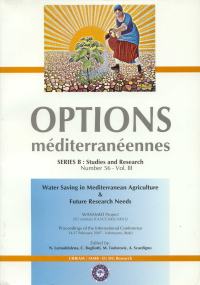| Article précédent | p. 181-196 | Article suivant |
Assessment of vulnerable zones to nitrate pollution: a study case in the Apulia region
The aim of this study is to implement a vulnerability assessment methodology of a zone to nitrate pollution. The Sinistra Bradano situated on the western part of Taranto (South of Italy) was the case of application. Focusing on this area, we produced the groundwater vulnerability map using the DRASTIC model. It produces a numerical value called DRASTIC index which is derived from the overlay of seven thematic maps related to seven hydro-geologic factors which are: depth to water, recharge, aquifer media, soil media, topography, impact of the vadoze zone and the hydraulic conductivity. The obtained vulnerability map was characterized by high to very high vulnerability. The groundwater chemistry showed that the maximum nitrate concentration found was 43.2 mg/l so all analysed samples were under the threshold of 50 mg/l and only 21 percent of them fall in the medium class. This percentage of samples confronted with the vulnerability map fall in the very high vulnerable zones. This actual nitrate concentration in groundwater was resulted from the application of the double of what is required as nitrogen fertilizers needs. Therefore, good agricultural practices are necessary to reduce and prevent further nitrate pollution.
Le but de cette étude est d'appliquer une méthodologie d'évaluation à la vulnérabilité d'une zone, à la pollution par les nitrates. L'étude de cas est située à Sinistra Bradano, dans la partie occidentale de Taranto, au sud de l'Italie. Une carte de vulnérabilité des eaux souterraines de la zone a été réalisée à l'aide du modèle DRASTIC. Celui-ci produit une valeur numérique appelée index, issue du croisement de sept cartes thématiques en relation avec sept facteurs hydrogéologiques : la profondeur de la nappe, la recharge, le type d'aquifère, le type de sol, la topographie, l'impact de la zone vadose et la conductivité hydraulique. La carte obtenue fait apparaître une vulnérabilité de haute à très haute. La chimie des eaux souterraines montre en effet que la concentration maximum en nitrate trouvée est de 43,2 mg/l. Tous les échantillons analysés sont sous le seuil des 50 mg/l et seuls 21 pour cent se situent dans une tranche moyenne, ce qui correspond, par rapport à la carte de vulnérabilité, à la zone de très haute sensibilité. La concentration actuelle en nitrates dans les eaux souterraines montre une utilisation des engrais azotés deux fois supérieure aux besoins. Il en résulte la nécessité de développer de bonnes pratiques agricoles pour réduire et prévenir la pollution par les nitrates.
- [ Afficher ]
- [ Télécharger ]
- [ Exporter la citation ]
Vous pouvez télécharger la citation au format :
- [ Imprimer ]
-
Mots-clés
CARTOGRAPHIE, EAU SOUTERRAINE, ENGRAIS AZOTE, ITALIE, MODELE, NITRATE, POLLUTION, POUILLESCiter cet article
Oueslati I., Vurro M., Uricchio V., Lamaddalena N. Assessment of vulnerable zones to nitrate pollution: a study case in the Apulia region. In : Lamaddalena N. (ed.), Bogliotti C. (ed.), Todorovic M. (ed.), Scardigno A. (ed.). Water saving in Mediterranean agriculture and future research needs [Vol. 3]. Bari : CIHEAM, 2007. p. 181-196. (Options Méditerranéennes : Série B. Etudes et Recherches; n. 56 Vol.III). Proceedings of the International Conference WASAMED Project (EU contract ICA3-CT-2002-10013), 2007/02/14-17, Valenzano (Italy). http://om.ciheam.org/om/pdf/b56_3/00800214.pdf



